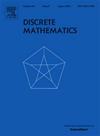A characterization of graphs with maximum k-clique isolation number
IF 0.7
3区 数学
Q2 MATHEMATICS
引用次数: 0
Abstract
For any positive integer k and any graph G, a subset D of vertices of G is called a k-clique isolating set of G if does not contain k-clique as a subgraph. The k-clique isolation number of G, denoted by , is the minimum cardinality of a k-clique isolating set of G. Borg, Fenech and Kaemawichanurat (Discrete Math. 343 (2020) 111879) proved that if G is a connected n-vertex graph, then unless G is a k-clique, or and G is a 5-cycle. At the end of their paper, Borg, Fenech and Kaemawichanurat asked for a characterization of all connected n-vertex graphs G such that . An old result of Payan and Xuong, and independently of Fink et al., in the 1980s has already answered this problem for the case . Very recently, the case when was solved by Boyer and Goddard, and the case when was solved by the first two authors of the present paper and Zhang. In this paper, we solve all the remaining cases. We show that except an infinite family of graphs, there are exactly 7 such graphs when and exactly such graphs when .
具有最大k-团隔离数的图的一个表征
对于任意正整数 k 和任意图 G,如果 G-N[D] 不包含 k-clique 子图,则 G 的顶点子集 D 称为 G 的 k-clique 隔离集。G 的 k-clique 隔离数用 ι(G,k) 表示,是 G 的 k-clique 隔离集的最小心数。343 (2020) 111879)证明,如果 G 是连通的 n 个顶点图,那么ι(G,k)≤nk+1,除非 G 是一个 k-clique,或者 k=2 且 G 是一个 5 循环。在论文的最后,博格、费内奇和凯玛维查努拉特要求对所有连通的 n 顶点图 G 进行表征,使得 ι(G,k)=nk+1 。20 世纪 80 年代,Payan 和 Xuong 的一个古老结果,以及 Fink 等人的独立结果,已经回答了 k=1 情况下的这一问题。最近,Boyer 和 Goddard 解决了 k=2 的情况,本文前两位作者和 Zhang 解决了 k=3 的情况。在本文中,我们解决了其余所有情况。我们证明,除了一个无限图族,当 k=4 时正好有 7 个这样的图,当 k≥5 时正好有 k+2 个这样的图。
本文章由计算机程序翻译,如有差异,请以英文原文为准。
求助全文
约1分钟内获得全文
求助全文
来源期刊

Discrete Mathematics
数学-数学
CiteScore
1.50
自引率
12.50%
发文量
424
审稿时长
6 months
期刊介绍:
Discrete Mathematics provides a common forum for significant research in many areas of discrete mathematics and combinatorics. Among the fields covered by Discrete Mathematics are graph and hypergraph theory, enumeration, coding theory, block designs, the combinatorics of partially ordered sets, extremal set theory, matroid theory, algebraic combinatorics, discrete geometry, matrices, and discrete probability theory.
Items in the journal include research articles (Contributions or Notes, depending on length) and survey/expository articles (Perspectives). Efforts are made to process the submission of Notes (short articles) quickly. The Perspectives section features expository articles accessible to a broad audience that cast new light or present unifying points of view on well-known or insufficiently-known topics.
 求助内容:
求助内容: 应助结果提醒方式:
应助结果提醒方式:


